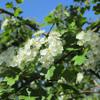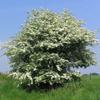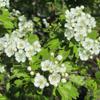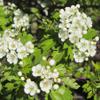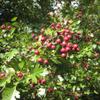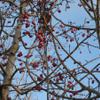Great choice! We're adding your items to the basket and working out what else you might need to plant it.
White Hawthorn Crataegus monogyna
Example photos only. Size, stem height and habit may vary.
Please contact us for photos of current stock.
Select plant type
Quantity
| Volume Discount | 1+ | 10+ | 50+ | 250+ |
|---|---|---|---|---|
| 60-80cm / Bare root | £3.70 | £2.11 | £1.58 | £1.32 |
British Grown – The British Grown logo denotes plants and trees that have been both propagated and grown in the UK. Read more
Product Description
CRATAEGUS MONOGYNA – White Hawthorn
Characteristics
There is no finer sight in May and June than the froth of heavy-scented hawthorn flowers overflowing in hedges. The native white hawthorn forms the basis of much of Britain’s countryside hedgerows, either trimmed as a hedging shrub or left to grow within the hedge as individual trees.
Grown as a tree it is small, making only around 7m (23ft) with a densely spreading, irregular outline. Shiny red berries, darkening as they ripen, cover the tree from late summer into winter providing food for thrushes, blackbirds and their winter cousins fieldfares and redwings.
As a hedge we recommend two rows, 45cm (18”) apart with the plants arranged in a staggered pattern, 4 plants to the metre. The impenetrable thorns make it a good barrier and its rate of growth is fast, giving rise to one of its other common names, ‘quickthorn’. You can plant a hedge entirely of hawthorn or opt for our ‘native mixed hedge’ where hawthorn makes up the majority of the mixture that other species can then be added to.
Where to grow
Hawthorn is easy to grow in all locations, tolerating windy and coastal conditions well. Plant in full sun or partial shade in freely draining soil.
Did you know?
Hawthorn is a tree surrounded by myth and legend. In Ireland it was known as the ‘faerie tree’ protected by spirits, and in parts of medieval Britain it featured strongly in May Day celebrations as a symbol of new life. Lone hawthorn trees stand out well in the landscape and were used by Anglo-Saxons as boundary markers.
Features
-
Mature Height
- Small - 5-10 metres
-
Spread
- 5-10 metres
-
Shape / Habit
- Shrub Multi-Stem
-
Growth Rate
- Fast
-
Soil Type
- All soil types
-
Sun Levels
- All Sun levels
-
Difficulty / Hard to Grow
- Easy
-
Evergreen / Deciduous
- Deciduous
-
Leaf Colour
- Green
-
Foliage
- Dense
- Early to Leaf
- Small leaves
-
Flowering Type
- Single
-
Flowering Month
- April
- May
-
Berries / Fruit Colour
- Red
-
Uses
- Small garden Tree
- City/Urban Sites
- Country/Farmland
- Encourages wildlife
- Bird Food
-
Hedging
- Flowering Hedge
- Native Hedge
- Berrying Hedge
-
Scent
- Scented Flowers
-
Thorny
- Yes
-
Native / Naturalised
- Native
-
Season
- Winter
- Spring
- Summer
-
Other Features
- Good at altitude
Aftercare
Pruning Crataegus monogyna
Tree:
Crataegus monogyna often branches from the base, if you are happy with this shrubby growth then little pruning is needed. If you would prefer a clear stem, train gradually as a standard; a cleared height of up to 2m can be achieved by the removal low laterals annually in the winter.
The crown can become congested on hawthorn trees. Remove stems that are severely crossing. If you are in an exposed position the hardy nature will be comprised through over pruning.
Hedge:
For a hawthorn hedge, clip annually in winter to maintain size and shape. If you want the hedge to flower, however, you should wait until after flowering.
What time of year is best to prune? Prune in winter, or light prune in spring after flowering.
For the continued healthy growth of your trees, shrubs or hedging it is vital that you follow the advice below.
Watering
The main reason that plants die within 12 months of having been planted is lack of water. It is essential throughout the spring and summer, to give a heavy enough watering to enable the water to penetrate right down to the deepest root level of the tree. In hot dry spells give the equivalent of 2 bucketfuls every three days.
Weed Control
One of the most common causes of lack of water is competition from grass. When trees are first establishing, the grass roots would be at the same level as the tree roots and are far more efficient at taking up water and thus choke the tree. It is vital that for at least 3 years after planting your tree or hedge has a circle or strip one metre wide completely free of grass.
- Mulch mats are an effective way to stop grass and weeds, although they will require a careful eye to make sure they continue to work. After clearing the ground around the tree, firmly fit the mat by tucking the edges into the soil and put a thick layer of bark mulch on top of this. Be careful not to allow the woodchip to touch the stem as it can cause rot.
- Weed killer is very effective, however it is harmful to the environment. Organic weed killers usually do not kill roots. Weed killer needs to be applied each year for the first 3 years, preferably when the tree is dormant, or just once before applying a mulch mat.
- Mowing or strimming is NOT an answer to the problem. Each time you mow, the grass will grow back more vigorously and strimming invariably leads to lacerated trunks.
Staking
If trees are not correctly secured they will rock in the planting pit. Roots not firmly in contact with the soil are unable to take up moisture and nutrients, resulting in die back or death of the tree. Check, particularly after windy weather, that stakes are still solidly in the ground keeping the base of the trunk firm. The purpose of the stakes is to anchor the roots. Flexing in the wind, higher up the trunk, is not necessarily a problem if the roots are firm.
Bellow is list of the correct system to use to secure your trees.
- 40/60, 60/80, 80/100 whips - Unless rabbit/deer problem no need to stake.
- 100/125, 125/150 1.2m Cane and Easi tie.
- 150/175 1.2m square stake and a buckle tie and spacer.
- 175/250, 6/8, 8/10 15L 1.65 Tree stake and a buckle tie and spacer.
- All larger trees. 2 x 1.65 Tree stake and cross rail with 38mm cushion spacer and 1m of 38mm strapping.
Ties
Always use our recommended tree ties or strapping. These are designed and manufactured with the correct amount of give to hold the tree firm without strangling it. They should be checked at the end of each growing season for adjustment as the trunk thickens. Non proprietary materials such as baler twine will cut into the bark and should not be used.
Protection from Animal Damage
Rabbits, deer, sheep, cattle and horses can all potentially damage trees. Ask us for advice on the most appropriate guards for your trees or hedge. Squirrels are also a terrible pest when trees get to about 20ft tall but there is no protection available.
Are the delivery costs the same no matter how many plants I order?
Yes the delivery costs stay the same no matter how many plants you have on your order. They are worked out based on your distance from our nursery and can be found here.






